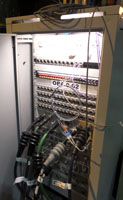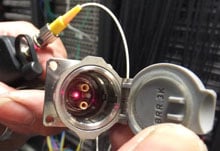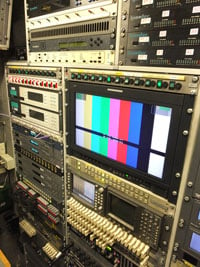Original URL: https://www.theregister.com/2013/02/20/from_stage_to_stream_the_brit_awards_2013/
From stage to stream: The unseen tech at the BRIT Awards 2013
You'll never moan about the price of Thunderbolt cables again
Posted in Networks, 20th February 2013 12:43 GMT
Feature If you think you know all about the O2 Arena having visited it when it was called the Millennium Dome, then think again.
When the site was sold to entertainment biz AEG in 2004, it was gutted and turned into a concert venue; all that remains of the original structure is the tent. Today, its owners claim it’s the busiest live venue on the planet.
It’s a transformation that involved fitting it out with audio and video interfacing to accommodate the latest digital standards, along with conventional analogue signal paths. The upshot of it all is miles of copper and, more importantly, optical cabling delivering pristine quality for stage and broadcast.
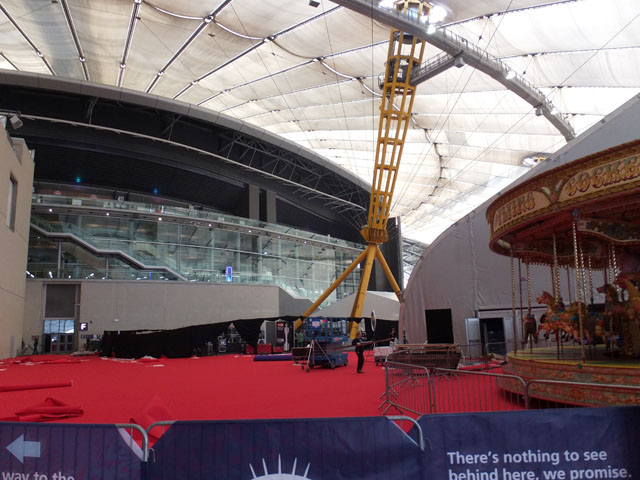
Nothing to see? Well not until later, but they've already rolled out the red carpet in the hospitality area
Tonight, for the third year running, the O2 Arena hosts the BRIT Awards which presents a range of challenges beyond putting on a show for the audience in the auditorium. The event involves juggling multiple live music acts with a live TV broadcast on ITV.
Forget the glamour, forget the cool video software, this is a get-your-hands-dirty view of the event that’s effectively a one-way, multicam video conference to an international multiplatform audience. With 30-odd cameras and up to 256 audio channels engaged in the event, a successful night for the outside broadcast crew has nothing to do with their favourite band walking off with a gong, but is all about getting the show from stage to stream without a hitch.
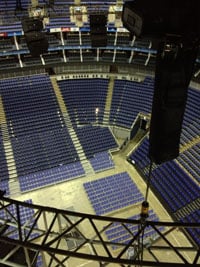
Quiet times: For tonight's BRITS, over 300
motors will arrange the overhead rigging
John Clerke has been in the professional broadcast video business for decades wearing a number of different hats and these days modestly refers to himself as the ‘patch man’ at the O2 Arena. It’s a critical role that ensures that audio and video is delivered to and from stage to whoever needs it. He’s been present at virtually all the events at the venue since its refit and has designed and overseen the installation of the AV cabling throughout the building. Well known in the business, he gives a very realistic view on how these events are organised.
“Most shows are self-contained and the only thing the crew want is power. The house PA gets used for conferencing but typically there's very little connection to the ‘house’ systems apart from things like getting the hearing aid loop to work. Most bands come with their own kit, PA, riggers – everything. They put it up in the ceiling, make it work and go away at the end of the evening.”
As with all major venues, what the production company brings along to the show has to be specified ahead of time. That includes gear like camera jibs, cranes and tracks – spider cams that fly around on wires are even banned in some places, so it makes sense to know in advance what’s allowed. The OB (Outside Broadcast) Manager works out where to put cameras, making it all near as possible to the various media panels that links back to the OB trucks with all the sound and vision mixing gear in them, among other things.
The 60 strategically placed media panels are key to the network of cabling that stretches across the venue via a central patchbay featuring the latest digital audio and video interfacing along with analogue options. Without this array, the show would be nigh-on impossible to produce as the media panels – each with their own carefully labelled connectivity – minimise unwieldy multicore runs on the venue floor and extend the reach of conventional cabling.
The media panels contain dedicated interface types for camera and audio use and feature fibre optic connectivity that can be used for either. There's no need for miles of chunky multicore when a single fibre can be used to shunt around 24-channels of broadcast quality audio. In the same patchfield, another fibre link could easily be distributing HD-SDI video to different equipment and facilities – given the distance limits with this video standard, optical comes to the rescue.
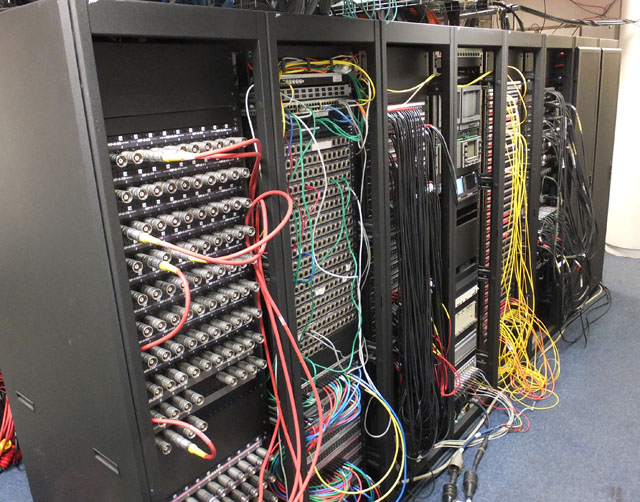
The media panels link to the main patch room which, from left to right features Triax, Ethernet, analogue audio, ST optical and SMPTE 304M connectivity, to name a few
There’s a bit of history behind these needs as Clerke explains, “When digital TV was developed they calculated what the longest length of cable in an average studio was and so standard def digital TV was developed to work at distances up to 300m. So when they designed the first Serial Digital (SDI) cabling protocol, that all worked very well in a standard studio. No probs.”
Making connections
With the increased data rate of HD-SDI, 100m is pretty much the limit as losses over long cable runs became more critical and problems ensued using the existing creamy PSF 1/3 or PSF 1/2 coax cable, favoured by the BBC, that had its origins in composite analogue video studios.

Triax, optical and SMPTE 304M patchbays: SMPTE 304M patch cables cost £500 apiece – makes Thunderbolt cables seem like a bargain
Click for a larger image
“Every joint in a digital cable adds about 30-40ft to the total length of the cable. So if you go through a patch field, you'll go through a BNC connector on to another connector then another – perhaps up to eight connectors in a patch field – which adds something like 200ft just by going through that patchfield. That's a problem. So if you have 100ft coming into there, you've already hit your 300ft [100m] limit. Yet in an OB truck, distances between everything are very short, so you don't have an issue cabling everything internally with [HD-SDI] video cable on BNCs."
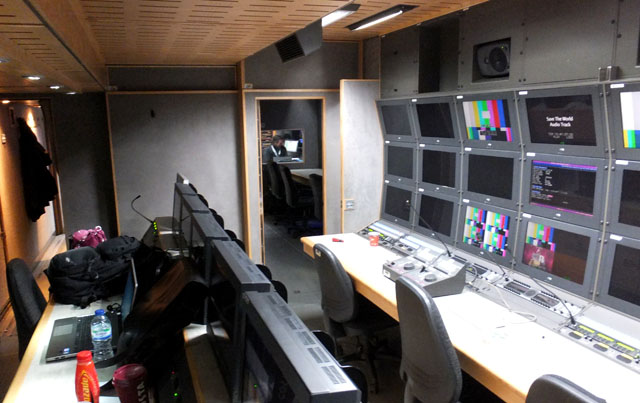
CTV OB truck vision mixing area and in the distance the audio mix room
Interestingly, the problem isn't so much to do with the camera cabling: optical can run over several kilometres and Triax copper wiring varies, pushing it at around 1500m for HD but most prefer to work within 500m. The cabling headaches are all to do with HD-SDI video signals that are being distributed from the outside broadcast truck for monitoring elsewhere. For instance, to frame a superimposed shot, two different camera operators would need to see the vision mix coming from the truck for positioning – cameras even feature a dedicated return feed button for this purpose. Monitoring aside, each camera has its own camera control unit (CCU) – dedicated hardware made by the camera manufacturer. The CCU can talk to the camera, controlling its zoom, iris, levels and other functions remotely.
Typically, cameras will be set up with either triax or SMPTE 304M cabling. Triax cable is the industry standard for connecting digital cameras. It features a copper core and two separate outer braids – it’s a signal combination enabling the picture, power and comms information to be conveyed to the camera control unit. That’s fine for most scenarios and is cost-effective too. The alternative standard camera cable is the specialised SMPTE 304M standard connector that utilises fibre optic cabling which brings both a distance advantage and a high price. Clerke explains how it all works in a SMPTE scenario.
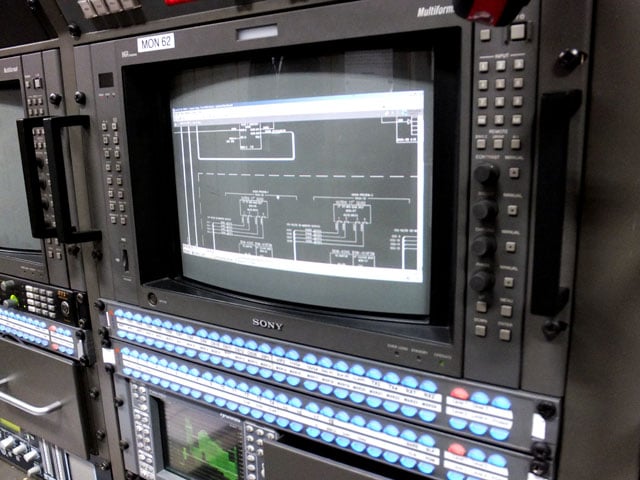
OB truck video matrix switcher
“The camera control unit lives in the truck and is connected by a SMPTE cable to the camera. At the back of the CCU there are BNCs and these are used to distribute [HD-SDI] video. Normally it goes into a matrix switcher so you can put video up on screen inside the truck and the mixer too. The truck matrix will usually be 64 x 64 or 128 x 128 and the camera input can be distributed anywhere, and a return feed goes back to the camera.
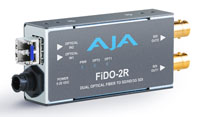
Aja FiDO 2r convertor handles fibre to HD-SDI
So if truck stays at back of the venue and the guy on the jib is on level 4 of the auditorium, he could be up to 600m from the truck in terms of cabling. We're never going to get that [HD-SDI] picture back from the truck to his camera on a bit of cable. Send it down fibre, convert it from fibre at the other end the last link into the camera and monitor itself will be 100m cable sitting on the floor.”
Vision On
The camera control unit is an essential dedicated device for broadcast video. Some cameras will have just a triax connector and other more expensive models will feature the SMPTE 304M interface. With the SMPTE 304M standard you get pairs of optical, data and power cabling and when you connect up the camera, the CCU initially sends out a low voltage of around 30-40V and the data pair interrogates the camera to find out what sort of it is. Once it knows it's one it can deal with, it then sends the full 180V down to the camera. After that, everything happens on the fibre – control, comms, video and audio too, although the latter is rarely used except for vox pops with the mic plugged in the side of the camera.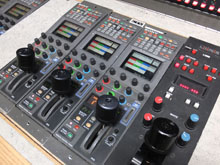
CCU remote control panel handles four cameras
Touching the joystick activates individual control
Click for a larger image
That preparatory probing is crucial given that a range of voltages are used on different cameras and you could easily blow one up without this check. There are legacy cameras you can use with a CCU too, so it has to be pretty careful. Also, in some outside broadcast environments, having a camera cable with 180V running through it can present safety issues. For instance, covering sporting events such as golf can involve long lengths of cable across the course. One approach is to run fibre round the golf course and locally, generate the high voltage the camera needs and that fools the CCU into detecting that there's a camera on the end.
Cable and wireless
You might think that wireless options could work but apparently their use is kept to a minimum to avoid interference. For boy bands wireless microphones appear occasionally but for TV, the operator with a steadycam and a camera running around for interviews are the only likely exceptions. Generally, cameras are on cables and the operators also have a cable puller – someone whose job is to take up the slack over the course of an event.
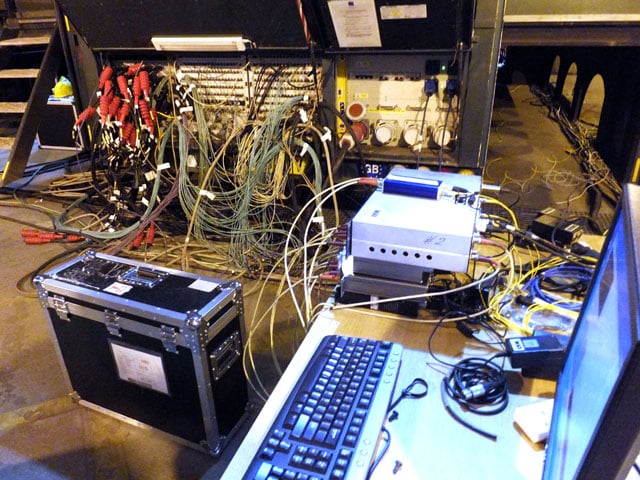
OB truck tailboard spilling out connections with various converters/splitter in the foreground
And talking of events, back to the main event itself. Freelancers dominate the industry these days as the major broadcasters seek to cut costs. Only the key personnel related to the OB team will be staffers such as the chief engineer, unit manager and a handful of other staff everybody else is a freelancer and that includes the main audio and vision mixers, camera operators, riggers – some double as rigger and camera ops too. Few network broadcasters have OB trucks, Sky has some but the BBC’s fleet of outside broadcast vehicles were sold off to SIS in 2008. The BRIT Awards is an ITV event and the hired hand lead broadcaster on this occasion is CTV. The company provides everything to cover the show and from its outside broadcast facilities will pump out the finished product for ITV’s network going via BT Tower.
Indeed, in the OB compound is a BT Openworld broadcast truck that, among other things monitors signal integrity before sending out an ASI MUX signal to the BT tower for distribution – ASI is the streaming version of SD/HD-SDI. Handling the data stream for the event is pro cast links engineer Raj Purohit who explains that even though there are two 270Mb/s connections available, ITV only requests a 90Mb/s data stream. So there's plenty of capacity on these lines and he has a back-up arranged on the second line which also feeds ITV 2. During the broadcast he uses a handheld Dolby Bitstream Analyser to check for CRC errors coming from the production output.
Being a one-off show, the audience display panels – the big screens to show the people at the back what’s going on – will also be run by CTV. However, touring bands will bring in their own camera team for this video display which is run from separate vision mixers as well. Even if a band’s performance is being televised, the images shown to the audience would be entirely different. One area where things don’t differentiate is sound. OK, so the front of house (FOH) mix to the audience will be different to the one that goes out on air, but both PA and broadcast sound engineers receive the same signals. It involves another patching job for Clerke and co.
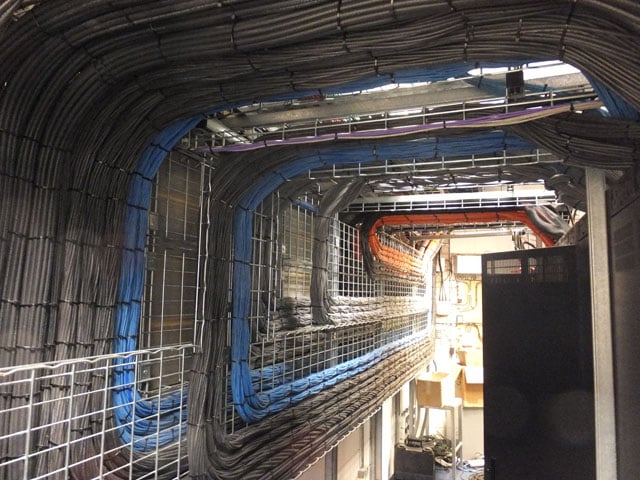
Cable TV? The back of the Arena patch room
“Every mic on the stage is split. All the outputs go to the house PA mixer, all the splits go to the OB truck. Normally, these feeds are on fibre these days and something like the BRIT Awards will be 128 to 256 feeds. With 8 or 10 bands, the drum kit alone will have 8-10 mics and on stage they may have 20-30 mics in total, so you just give them their own bank of controls on the mixing consoles. You can set-up the mix for them and leave it. So there are two main mixes going on: one for broadcast the truck is doing and another mix the house is doing for audience going out on the PA, plus a stage monitor mix so the band can hear themselves."
Making things easier still is the fact that the bands’ equipment is lined up behind the stage on palettes. One act after another, they just roll them out and wheel them in. As for sending the audio down fibre optic cable, this involves conversion too. For fairly self-explanatory reasons, multicore cables are referred to as ‘snakes’ and, in times gone by, a of run around 96 lines back to the OB truck wouldn’t be unusual, which is quite a pile of multicores.
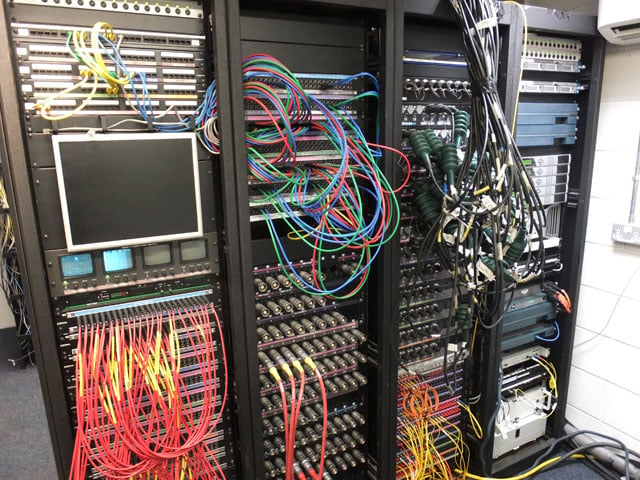
The OB compound has its own patch room and with those pricey SMPTE 304M patch cables in short supply, some trucks are bypassing the media panels and connecting directly to the third rack here. The fourth rack contains media servers for separate video feeds via Cisco DMP 4300 IP set-top boxes to the 360 Sony TVs in dressing rooms and public areas
Nowadays, using off-stage boxes such as Telecast's Adder for A/D conversion of the mic and other audio sources is performed to output the multichannel audio down just one bit of fibre, from one media panel to another at the other end with Adder D/A conversion as needed. Telecast also makes the Python converters for video HD/SDI to and from optical, to make the most fibre cabling. Given the various conversion stages for both audio and video, timing can be an issue. Audio conversion takes only microseconds, so it’s imperceptible, but some video configurations can be a bit tardy.
“You're allowed two frames between realtime and video before you start noticing timing issues and you need to keep within that window,” says Clerke. “Video processing can take a frame or so, and there’s normally a 32-line window on a video mixer. If you have a frame delay in vision and none in audio, that could be an issue, and so it’s sometimes necessary to time everything up in a truck to make sure everything gets to the right place at the right time.”
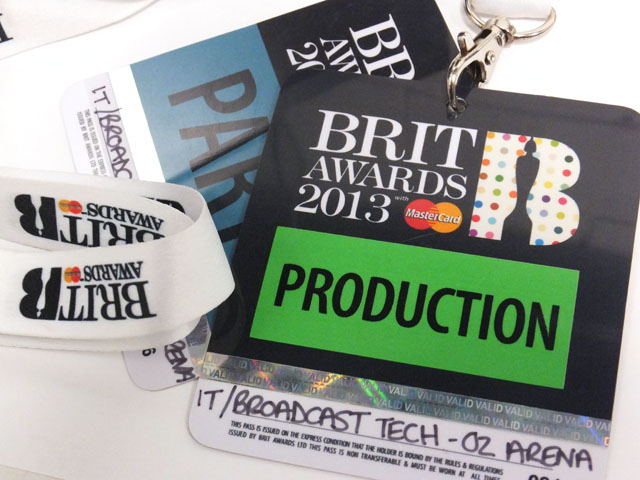
Access all areas, apart from a table at the show
Indeed, with a live event like the BRIT Awards, timing errors looking like dodgy miming wouldn't win you any friends among the performing artists. Other timing issues are critical too, as The BRIT Awards goes out on ITV, the ad breaks need to be fitted in with the 7.30pm to 10pm programming schedule. The news follows at 10pm and that’s a deadline that’s written in stone.
Still, if the event does run over, the action will be recorded too on EVS equipment – a popular broadcast hard disk recording system. Not only is it a failsafe approach should there be drop outs in the broadcast network, but content is kept for documentaries and archives too. Whether we’ll witness anything like Jarvis Cocker’s stage invasion during Michael Jackson’s BRIT Awards appearance back in 1996 remains to be seen, but you never know. ®
